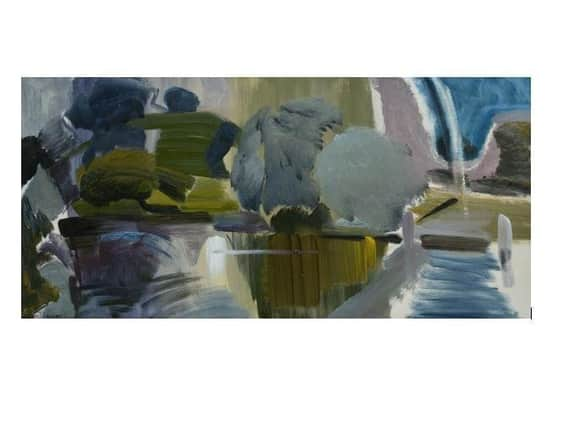Ivon Hitchens painting on the open market for the first time


It was bought as a wedding present by the parents of the current owners in 1957, directly from Hitchens at his studio and has remained with the same family ever since.
The public will now be offered the opportunity to obtain the work for the first time, at an auction of Modern & Contemporary Art at Dreweatts on March 18 2021.
Hitchens lived for many years near Petworth.
Advertisement
Hide AdAdvertisement
Hide AdJennie Fisher, joint head of Dreweatts picture department; modern and contemporary art, said: “Wittenham Clumps from Days Lock is a superb example of Hitchens’ panoramic abstract landscape works which contain swathes of colour across the canvas to create form. The grey sage green, interspersed with greys, whites and violets draw the viewer’s eye over the water to the landscape beyond.
“Lines in the foreground contrast with the curve of the hills in the distance to create a sense of balance and harmony. It is estimated to fetch £30,000-50,000.
Jennie added: “We are thrilled to be offering this exciting work by Ivon Hitchens. The fact that it is fresh to the market and has such a lovely provenance makes it even more special and we hope that the new buyers will treasure it as much as the family have, for so long.”
“Hitchens began painting in the 1920s in London, his creative, elongated landscapes and innovative use of block colour became his signature style.
Advertisement
Hide AdAdvertisement
Hide Ad“With Winifred and Ben Nicholson, Barbara Hepworth and Henry Moore, Hitchens was a pioneer of early 20th century art. Founding The Seven and Five Society in 1919 it shifted from traditional art, to the more modernist style, which culminated in Britain’s first all-abstract art exhibition in 1935.
“When his house was bombed during the WWII he decamped to a caravan in woodland near Petworth in West Sussex, where he lived for the next forty years, adding outbuildings to create a working studio. Such was the popularity of his work, that he received many significant commissions, such as one for a huge mural in the main hall of Cecil Sharp House. He also represented Britain at the Venice Biennale in 1956, which was the first opportunity for an international audience outside of Britain to see a group of his paintings exhibited collectively.
“Making the present work even more interesting is that we have a personal insight into the artist and his work process. Wittenham Clumps from Days Lock was acquired as wedding present in 1957, which set in motion a series of letters between the family and Hitchins.
“Although many of the letters detail practicalities, such as a hand-drawn map of how to find the studio, they also show Hitchins’ character as a considerate and kindly man, who was happy to devote a whole day showing his paintings to interested buyers and discuss them in great detail. Even more interestingly, they reveal a direct insight into his working methods and processes.”
Advertisement
Hide AdAdvertisement
Hide AdAn excerpt from an account of the family’s studio visit also offers a glimpse of Hitchens the artist and person: “He seemed in no hurry, and curiously objective about his own work as though he were an outsider seeing it for the first time. Many canvasses were unfinished. He explained that he always knew what he was going to try to achieve but never how he was going to get there. He always started from nature (or from an interior or model). The first rendering was often relatively representational, the verticals and horizontals, light and shade, re-producing what was in front of him – up to a point.”
It was only after some considerable time that they came close to making a decision on a painting and, remarkably, the day ended with them agreeing on not just one painting, but two:
“We spent the whole afternoon, looking at and discussing painting after painting. Eventually the choice was narrowed to two; one I liked, one Hitchens liked and wanted us to have. The one I liked was not, Hitchens said, finished – or satisfactory. The one Hitchens preferred had just been completed – ‘Wood Landscape no. 2’, of 1956. He looked again at the one I preferred – ‘Day’s Lock, Wittenham Clumps’ – and agreed there was something missing on the right-hand side. Picking up a large brush dripping with a characteristic mixture of grey, light blue and purple, he swirled in a sort of arching rainbow against the deep blue of the sky on the right. “There”, he exclaimed, “That does it, I think”. I wanted the picture more than ever, but he still wanted us to have the other. We explained that we were broke and could not possibly afford both. After long discussion, “I’ll tell you what”, he said, “why don’t you take both – for the price of one”. And, despite our protests, that is what eventually happened.”
The timing of the visit in 1957 coincided with the opening of Hitchens’ exhibition at the Musée National d’Art Moderne in Paris. Today his paintings are in the collections of the Tate Gallery in London, the National Galleries of Scotland in Edinburgh, and the Courtauld Institute in London, amongst others.
Advertisement
Hide AdAdvertisement
Hide AdTo see the full cataloguing of the work, which will be offered in the Modern & Contemporary Art sale at Dreweatts, visit https://auctions.dreweatts.com/auctions/7750/drewea1-10210/lot-details/7ce1d23f-3e04-4b8c-86e7-acd100fdab50